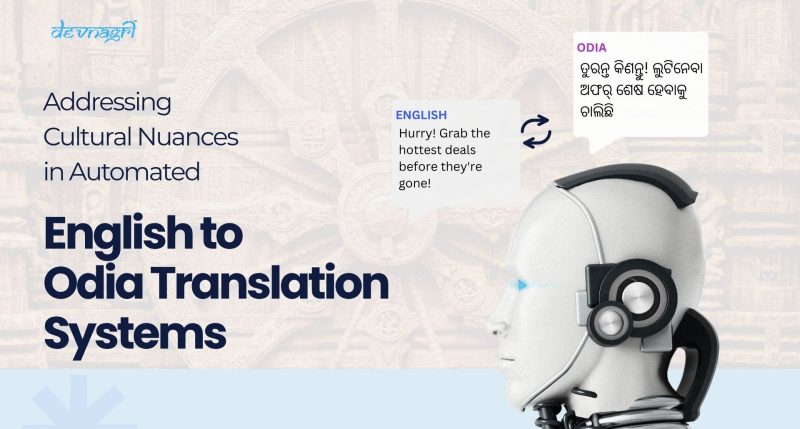Let’s be real, content marketing in India is crowded. Everyone is writing blogs, running campaigns, and posting reels. But the question is, are they actually connecting? Not always. Because most of it is in English, sometimes Hindi, and it misses the real language people think in every single day.
Now, Odia doesn’t usually show up in these marketing talks. But it should. It’s one of the most spoken languages of India, with over 40 million speakers. That’s not a small side market; it’s bigger than the population of many countries. If your brand ignores Odia, you’re leaving out people who might trust you more if you just spoke to them in their own words.
And here’s where English to Odia translation isn’t just nice, it’s smart business. With the right setup, you don’t end up stuck in endless manual work. What used to take weeks can now move along in days, or sometimes, just a few clicks. A translation API can sit right inside your system, quietly turning your English copy into Odia. It feels simple, but it shifts the way people see your brand.
Why Odia Is Worth Paying Attention To?
Think about Odisha for a second. The digital wave has hit hard. Cheap smartphones, low-cost data, social platforms everywhere. People are online constantly. But what do they see? Mostly English ads, or Hindi. Now imagine you’re scrolling and suddenly you see a brand wishing you in Odia. You pause. Because it feels closer. It feels like it’s for you.
That’s what builds trust. And trust, let’s not kid ourselves, is what turns into sales.
Social Media That Doesn’t Feel Outsider
Social media is the noisiest street you’ll ever stand on. Everyone is trying to get noticed. But relevance wins more than volume. A simple post in Odia during Durga Puja? That hits home. A meme in Odia? It’ll spread faster than a slick English post because people relate instantly.
This is where automation helps. With a translation API, your English draft doesn’t sit stuck in a file waiting for manual edits. It flips into Odia fast, ready to post. That’s scale, without losing local touch.
Websites People Actually Trust
A website isn’t just a digital address anymore. It’s the store, the salesperson, the FAQ, all rolled into one. If a customer lands there and only sees English, they might stay; they might not. But in Odia? They’ll actually read, understand, and maybe even click “buy.”
Take an eCommerce site. Listing specs in Odia is like handing customers a guide they don’t have to guess through. Trust goes up. Support calls go down. Everyone wins. And again, a translation API makes sure new updates flow in Odia without a manual rewrite every single time.
Apps That Feel Like They Belong
Open an app in English, and you’ll manage. But open it in your home language, and suddenly it feels like it was designed for you. Finance apps, shopping apps, and even health apps, localization changes everything.
I heard about a banking app that added Odia. Suddenly, terms like “loan repayment” and “interest” weren’t confusing anymore. People used more features. That’s what app localization does: it takes friction away. And fewer barriers mean more engagement.
Documents That Speak Clearly
Here’s something people forget, content marketing isn’t only campaigns. Sometimes it’s those boring-but-important documents: agreements, finance papers, reports. If these stay in English only, customers nod but don’t always get it.
Translate into Odia, and suddenly the fine print isn’t scary. People understand what they’re signing up for. In finance translation, especially, that matters. It saves customer support time and shows regulators that you take clarity seriously.
Local Campaigns That Don’t Feel Copied
Here’s where strategy matters. Don’t just translate after the campaign is done. Build Odia in from the start. Think of local festivals, like Raja Parba, or local shopping patterns. A food delivery brand running deals during Raja Parba with Odia copy? That doesn’t just look local, it feels like it belongs.
That authenticity is what separates brands that last from brands that look like outsiders.
Field-Tested Ideas You Can Try This Quarter
You don’t need a giant rollout to see results. Pick two or three of these, ship them, learn, repeat.
- Fix the first click
Start with the most-visited page (usually the homepage or a top category). Add a clean Odia version, headline, CTA, and 2–3 key benefits. Not the whole site. Just enough to prove lift. If bounce drops, you’re onto something. - Festival quick wins (low cost, high love)
Raja Parba, Rath Yatra, Durga Puja, and timelines are predictable. Draft English once, then prep Odia captions and a square image template. Publish across Instagram, Facebook, and WhatsApp Status. Local pride does the sharing for you. - Product cards that read like a friend
Short specs in Odia under the English ones. Think: “Battery life, ଦିନଭରି ଟିକେ।” It’s small, almost a whisper, but it removes doubt at checkout. - Support that actually supports
Turn the top five FAQs into Odia. Pin them where people look: order tracking, returns, payments, and warranty. Your call center will notice the difference before your dashboard does. - Micro-videos, zero studio
A 20–30 second screen-record with Odia subtitles: how to place an order, apply a coupon, check EMI. Shot on a decent phone, posted weekly. Consistency beats polish. - App nudges that feel native
Two items: onboarding tips and push notifications. Make both available in Odia. “Offer ends tonight” hits harder when it reads like your cousin texted you. - Paperwork, the silent churn
Banks, insurers, and clinics translate the forms people dread. Plain Odia, no legal gymnastics. Add a tiny note: “We tried to keep this simple.” You’ll earn trust you can’t buy. - Local faces, local places
A Bhubaneswar café tag, a Cuttack landmark in the frame, a Pahala rasgulla reference, tiny anchors that say, “We’re here, not guessing from far away.” - Ask for feedback in Odia (and mean it)
One line at the end of a chat: “ଆପଣଙ୍କ ମତ କ’ଣ?” You’ll get shorter, sharper replies, and real copy you can reuse (with permission). - A weekly rhythm
Pick a day. “Odia Thursdays.” Blog snippet, one post, one short reel. Systems beat motivation.
How to measure without over-engineering
- A/B the Odia headline for two weeks; track bounce and add-to-cart.
- Tag Odia posts; watch saves/shares vs. English.
- Note support tickets by language; aim for fewer “I didn’t understand” tags.
None of this needs a moonshot budget. It needs focus, a bit of humility, and the willingness to talk like the people you want to serve.
The Bigger Picture
The pattern is clear: English to Odia translation is not just a language move, it’s a growth lever. Websites, apps, documents, memes, every touchpoint gets stronger when it speaks Odia. And modern translation APIs make it scalable. No messy back-and-forth, no massive delays.
Skip Odia, and your campaign might just blend into the noise. But lean into it, and people will pause, notice, and maybe even remember your name the next time they need what you offer.
Conclusion
Because, let’s be honest, marketing isn’t really about who shouts the loudest. It’s about who connects. And the quickest way to connect? Speak in the language your audience already thinks in. That’s where trust starts, and trust is what keeps business moving forward.
Not volume, not fancy graphics, but connection. And the fastest way to connect in Odisha? Speak Odia. English will get you through the door, sure. But Odia lets you sit at the table, have a conversation, and be trusted.
So the next time you plan a campaign, ask yourself: Does it sound like your customer? If not, maybe it’s time to switch the language. Because the brands that adapt to the most spoken languages of India will be the ones leading tomorrow.



